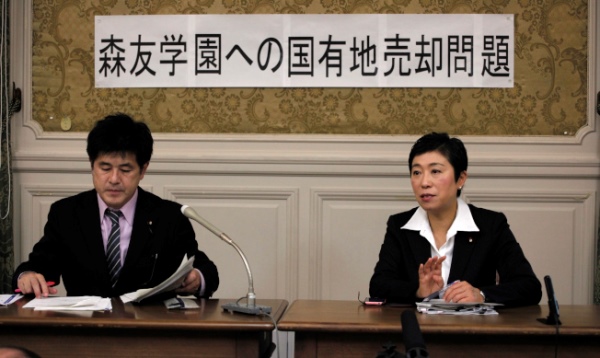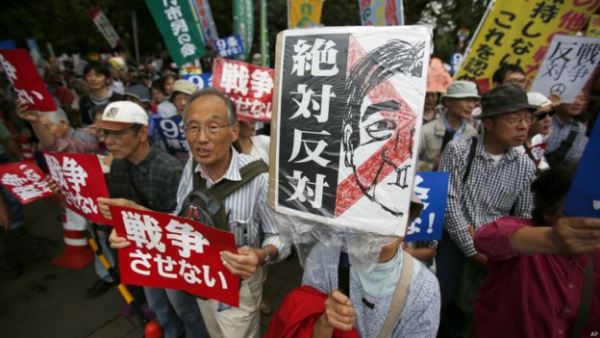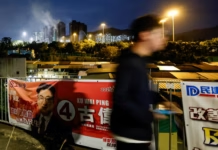Political landscape has been shaken up in Japan. The victory of Abe does not promise a stable future
Carl Simmons, CWI, Osaka
The victory of Abe Shinzo in the October 20 general election opens up the possibility of him becoming the longest serving post-war Japanese Prime Minister. However, appearances can be deceptive, and his overwhelming victory does not indicate that the path ahead for him will be smooth or that Japan is set for a new period of stability.
The first question is why Abe decided to call an election at all. A Lower House election was not due for another year. With his coalition partner, the Buddhist party, Komeito, he already enjoyed a two thirds majority, enough to propose amending the constitution along the lines that he wants on the issue of military action. The reality is that Abe’s government has major problems.
The present upturn in the real economy is due more to construction for the Olympic Games in 2020 and Asian tourism – particularly from China – than ‘Abenomics’, as his economic policies have been called; most Japanese have not benefitted substantially. Despite an acute labour shortage, wages are not increasing substantially. There is a widespread perception that inequality is growing and that Abe’s policies have only benefited the major companies.

Stormy waters
In addition to this, his government has run into stormy waters. Abe and his wife are suspected of involvement in arranging for land to be made available for an elementary school run by an ultra-rightist in the Osaka prefecture. The school, Moritomo Gakuen, also claimed millions fraudulently for work supposedly clearing the land of heavy metals that was never completed. In addition, public opinion was shocked when details of the school’s curriculum emerged. As well as learning the reactionary imperial re-script on education, videos emerged of a sports day where the students were ordered to recite slogans in support of Prime Minister Abe. This was just too much even for the majority of Abe’s supporters and he was forced to disassociate himself from the school and deny any involvement.
Other scandals have included direct involvement in arranging for a private university run by a friend of Abe to get funds for a new department. His defence minister, Inada, a deranged ultra-rightist, was forced to resign for ordering the falsification of Self Defence Force logs.
In the July’s Tokyo Municipal elections, Abe’s party suffered a devastating defeat to a new party created by Tokyo Governor, Koike Yuriko, a former Minister of Defence in the Abe government. She made it clear that she also had national ambitions. Abe could see the writing on the wall for his government. In particular, he feared that he would no longer be able to achieve his lifelong ambition of amending the post-war constitution. He called a snap election, hoping to capitalise on the weakness of the opposition and the economic improvement and was also calculating that the Korean missile crisis would boost support for his party and its nationalist agenda of amending the constitution.
Weakened opposition
The main factor in Abe’s success is undoubtedly the weakness of the opposition. Prior to the election the main opposition was the Democratic Party (Minshinto – literally ‘Democratic Progress Party’ in Japanese). It was a party artificially cobbled together, consisting of opposition diet [parliament] members of widely different political persuasions – from those who consider themselves on the left, to out and out nationalist conservatives. The party was supported by the largest trade union federation, Rengo. It was the failure of this party in government – breaking pretty much all of its policies, including a key plank of its election programme, not to raise the Consumption Tax – that paved the way for Abe’s second spell as Prime Minister. The party never really recovered from the defeat in 2012.
Following the passage of Abe’s Security Bill in 2015, which allowed for the participation of the Self Defence Forces in combat in support of allies outside of Japan, the party had been in a loose electoral alliance with the Japanese Communist Party and the Social Democratic Party. This alliance was opposed by the conservative wing of Abe’s party, and, for their own reasons, the leaders of the Rengo trade union federation.
New party of the right
When Abe called the election, Maehara, the recently elected leader of the Democratic Party, a member of its conservative wing, to the shock of many of its members decided that the party would not stand candidates in the election. Instead its candidates should seek to stand as candidates of The Party of Hope, the new party formed by Koike Yuriko, the Tokyo governor after she left Abe’s party, the Liberal Democratic Party (LDP).
The Party of Hope was widely promoted in the media as the party most likely to defeat Abe. However, despite its talk of a “caring conservatism”, Koike was not even from the liberal wing of the ruling party. In her youth she had supported the fascist Tatenokai, a militia run by ultra-rightist novelist Mishima Yukio. She had also been a supporter of the xenophobic Ishihara Shintaro, a previous Tokyo governor. She is still a member of Nihon Kaigi, the nationalist pressure group. Koike announced that former Democratic Party members joining her party would be required to support constitutional revision and the legality of Abe’s security law, which had been opposed by a majority of the population. Despite the hype in the media it soon became apparent that if Koike was to have her way voters were going to have a choice of two conservative parties, both committed to constitutional revision.
Koike’s party was widely seen as a second right-wing party. Many believed that she was quite prepared to enter a coalition government with Abe after the election. Although she was forced to deny this publicly during the campaign, her denials lacked conviction. In a “vote of confidence” in her own chances of success she announced that she would not give up her position as Tokyo Governor, and would therefore be ineligible for the position of Prime Minister, leaving her party without a candidate for the post. She actually spent the election day in Paris on ‘other business’!
This new party’s programme was dubbed the twelve zeros. It included the abolition of hay-fever, of crowded commuter trains and ‘power poles’, without a concrete description of how these were to be achieved and was greeted with incredulity. As her campaign began to lose momentum, so did the enthusiasm for it from former Democratic Party parliamentary representatives. The Upper House Democratic Party members announced that they had not yet decided to wind up their party and join the “Party of Hope”.
Another new party
The “Party of Hope” was also hit by the formation of another new party by individuals on the liberal wing of the Democratic Party. Edano Yukio, a popular ex-lawyer, announced the formation of a Constitutional Democratic Party. His decision was apparently heavily influenced by the Twitter campaign waged by former members of SEALDs, the youth movement opposed to Abe’s security law. The hashtag “Edano tate”, “Edano stand”, went viral and the new party soon had more followers on Twitter than the ruling party. Edano’s formation was joined by the group around Kan Naoto and the faction of former Japan Socialist Party members in the Democratic Party. The party made an electoral agreement with the Social Democratic Party and the Japan Communist Party.
This group adopted a programme of reforms that included a rise in the minimum wage, regulation of long overtime hours, equal pay for work of equal value, free high-school and university tuition. It also called for restoration of rights under the labour law for public sector workers, including the right to strike, taken away from them in 1952. The programme included defence of article 9 of the constitution (which renounces the use of war), the scrapping of Abe’s new conspiracy law, an end to the restarting of nuclear power stations, support for LGBT rights and a ban on corporate finance to political parties.
The election thus developed as a contest between three blocks. The ruling block of the Liberal Democratic Party and Komeito, the conservative opposition block of The Party of Hope and the Kansai-based Japan Renovation Party (Ishin), and finally the block of the Constitutional Democratic Party, the Japan Communist Party and Social Democratic Party. Given a divided opposition, dominated by two parties that were less than three weeks old, it is little surprise that Abe easily held his two-thirds majority. However, both ruling parties, lost seats compared to their pre-election totals.
The Party of Hope won only 50 seats in spite of having 57 candidates who were members of the Diet (Parliament) before the election. It was beaten into 3rd place by the Constitutional Democratic Party, which emerged as the largest opposition party. This was the only party to make gains in the election increasing its representation from 15 to 55 seats. It benefitted from an electoral pact with the Japan Communist Party. The JCP stood down in single seat constituencies where they had little chance of winning. The JCP lost seats in the proportional representation section as its vote fell from 11.37% to 7.9%, where the newly formed CDP picked up most of the votes of left-wing voters, leaving the JCP with 11 less seats than it held before the election. The SDP’s vote fell to just 1.69%.
The CDP, with 19.88% of the PR vote, has been described as a new party of the left in the foreign press. The conservative parties accused it of being the “rebirth of the Japan Socialist Party.” Many activists viewed the breakup of the Democratic Party as a positive development. The reality though is a lot more complex. While the programme of the new party is for radical reform, there is no mention of socialism or any kind of alternative to capitalism. In fact the leader and candidates repeatedly claimed that the party was neither right-wing nor left-wing. While none of the original 15 Diet members had any kind of background in the LDP, a number of them associated with Edano’s faction were previously members of the neo-liberal Minna no To (Your Party.)
The CDP is only three weeks old and its future development is not yet clear. It is a populist party rather than a working class party. Edano has ruled out trying to patch together the Democratic Party. However, he has been courting the leaders of the Rengo and the pressure will undoubtedly increase to “broaden the party’s appeal” by allowing more conservative former DP members to join. The seeds of destruction of the Democratic Party are to some extent also present in this new party.

Election victory no guarantee of success
The two-thirds majority for Abe in the election and the fact that the conservative opposition parties could be expected to support him too, make a push for constitutional revision likely. However, he also has to win a majority for revision in a referendum. It is by no means certain that he will get this with recent polls showing around 50% opposed.
While Abe was able to use the perceived threat from North Korea to boost support, there is no nationalist wave. Rather the thinking of many voters was along the lines of: “These other parties are new, we can’t really trust them in a crisis like this. The LDP has more experience dealing with North Korea.” Some opinion polls even indicate that there was a majority opposed to Abe’s hardline against North Korea. In particular there is unease at his closeness to Trump. A Mainichi News opinion poll showed that 47% of voters would prefer not to see Abe stay in office and a mere 37% want him to remain.
While the constitution will be the subject of an important battle in the next year, it was not the most pressing problem facing voters. Pensions and welfare have repeatedly topped issues seen as important by voters. While around 80% of JCP members see constitutional revision as a burning issue, only 6% of LDP supporters do.
What is needed is a new party of the working class, based on fighting unions and citizens’ groups that doesn’t just fight in elections, but supports all the struggles of the oppressed. A party has to be built that can link the struggle against constitutional revision to the fight for the kind of reforms contained in the programme of the new CDP, but that links them to the need to break with capitalism and fight for a socialism.




